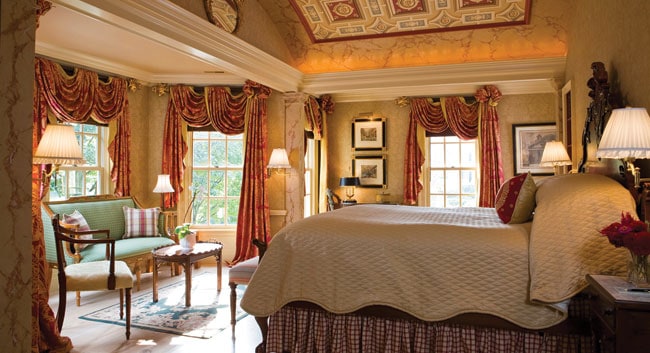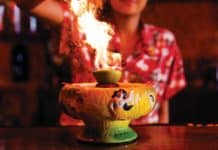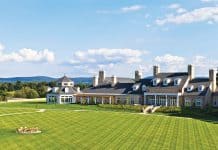Located in Virginia’s historic town of Washington, the AAA Five-Diamond Inn at Little Washington flaunts the town’s lavish side as it was in the 18th century: a European-inspired courtyard, tables laden with crystal and silver, richly layered fabrics, colors and textures, amethyst-studded ceilings, art and antiques. The 24-room inn anchors a campus-style village with numerous places to meet.
The Ballroom is the more traditional venue, located in an 18th century building just across from the inn where town meetings were held during the Civil War. Its main claim to fame, however, is George Washington, who danced the minuet within its colonial walls. The building now resembles an imperial Chinese garden pavilion with hand painted wallpaper and a trellised ceiling over a cloudy blue, trompe l’oeil sky. Groups of 24 can meet here amid this rare historic ambience, state-of-the-art technology and Blue Ridge Mountain views.
Dining is an overall experience at the inn, with silk rose-colored lampshades floating above tables and Windsor Castle-inspired décor—from Portuguese tiles and a King Arthur-inspired range to bay windows with garden views. Wine tastings from the 14,000-bottle wine cellar and pairings by a sommelier are a popular on-site group activity. Most groups come to the inn to experience its rich natural landscapes and historic connections, however. Local streets were surveyed and named by George Washington in the mid-18th century; current “colonial” communities are represented by architecture ranging from the 1700s to present day.
After enjoying complimentary afternoon tea, groups can hop on bicycles to explore art galleries, antique shops and theatres. “Pick your own” fruit orchards and wineries are also nearby, or groups can venture further out to tour the Luray Caverns or Montpelier Estate and Monticello, the former residences of James Madison and Thomas Jefferson. The Skyline Drive, built by the Civilian Conservation Corps during the Depression, offers 75 scenic overlooks of the Shenandoah Valley and Virginia Piedmont.











